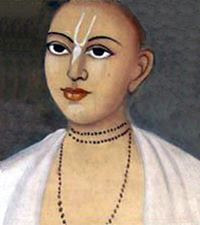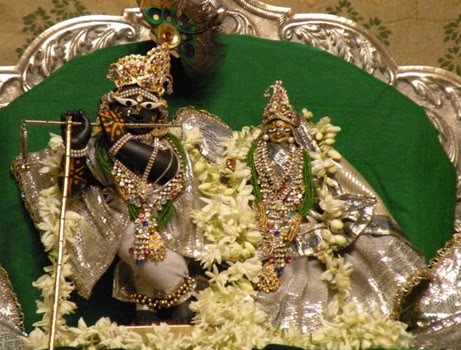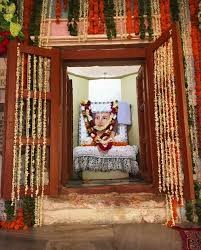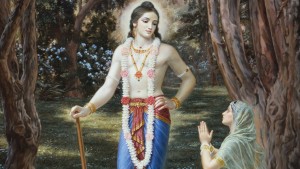
Amongst the Goswamis, Lokanatha was the eldest. He was always intensely absorbed in loving ecstatic mellows.

It is very difficult to describe the character of Lokanatha Goswami, who was so dear to Mahaprabhu. When Mahaprabhu and some of the other Goswamis began their pastimes of disappearance, Lokanatha maintained his life only due to the desire of Mahaprabhu. Sri Lokanatha Goswami initiated Narottama dasa Thakur. There is no mention anywhere of any other disciple of his. It is not possible to describe the care with which Narottama Thakura served his guru. In the early morning he would clean the place where his guru passed stool and urine.
In a dream however, Prabhu came to console Lokanatha and requested him to stay at Vrindavan. Thus Lokanatha remained at Vrajadhama, not wanting to neglect the order of Mahaprabhu. He stayed alone, his presence unknown to anyone. But after some days he met the dear disciples of Mahaprabhu – Sri Rupa, Sri Sanatana, Sri Gopal Bhatta, Sri Bhugarbha, and others. They were all very affectionate to one another and it was as though they were of one mind.
Being afflicted greatly by separation from the Lord, he set out to tour the holy places, and then finally came to Vrindavan.
“With tears flowing from his eyes Lokanatha offered his obeisances to Mahaprabhu. The omniscient Lord lovingly embraced him and after explaining some hidden truths to him, He instructed him to go to Vrindavan. Thus Lokanatha, after surrendering himself at the lotus feet of Mahaprabhu, set out for Vrindavan in the company of Bhugarbha Goswami.
In Navadvip Sri Gaurasundara very lovingly embraced Lokanatha and instructed him to go to Vrindavan as soon as possible. Lokanatha could understand that Mahaprabhu would renounce His family life within a few days and he was aggrieved at this. Mahaprabhu consoled him and told him that they would meet again in Vrindavan.
He came to Navadvip in the age of fifteen and started studying devotional science at Advaitacharya’s school. Sri Gauranga and Gadhadara Pandit were his classmates here. Being pleased with his devotion, Acharya himself initiated Lokanatha.
Lokanatha was in bliss and being immersed in that ecstasy, he prepared some foodstuffs and offered them to Radha-Vinoda. Then he made a bed of flowers and made the Deity lie down to take rest. He fanned the Deity with some leaves and meditated on massaging the lotus feet of his Lord. Having surrendered his body, mind and very life itself, he was totally absorbed as though drinking a flow of honey-like nectar.

Lokanatha Goswami used to visit many places of Krishna’s pastimes within Vrajadhama and in this way he was always absorbed in intense ecstasy. Lokanath came to the banks of Kisori-kunda within the village of Umrao, by the side of Chatrabon, and remained there for a few days. Lokanatha wanted to worship the Deity form of the Lord, and Sri Krishna, who is within the heart of everyone, thus presented a Deity form of Himself to Lokanatha to worship. This Deity’s name is Sri Sri Radha-Vinoda. Having received this Deity, Lokanatha looked up to see who had brought Him, but seeing no one present he began to reflect on the mystery of His appearance. Seeing Lokanatha deep in thought, Radha-Vinoda laughed, “Who would have brought Me here! I have come Myself! I live here on the banks of Kisori kunda and this is My village – Umrao. Now please give me something to eat.”
Lokanatha Goswami, having become quite advanced in years, entered into his eternal pastimes, while residing at Khadirvan (Khoyra gram). There is a large lake there called Sri Yugal kunda on the banks of which his samadhi has been established. His worshipable Deities Sri Sri Radha-Vinoda are at present being worshiped in Jaipur, Rajasthan. His pushpa samadhi is within the courtyard of Sri Gokulananda Mandira.
Meanwhile Sri Chaitanya Mahaprabhu accepted sannyasa and then came to Nilacala. After some time, when Mahaprabhu set out on His tour of South India, Lokanatha, having received this news also journeyed to the south. Then Mahaprabhu came to Vrindavan; Lokanatha followed Him there. But by the time he reached Vrajabhumi, Mahaprabhu had already left for Prayaga. Lokanatha was extremely sad. Again having missed darshan of his Prabhu, He decided to leave the next morning for Prayaga.

Srila Loknatha Gosvami was born in the village of Talkhari in 1540, within the district of Jessore, Bangladesh, as the son of Sri Padmanabha Bhattacharya and his wife, Sri Sita devi. Sri Padmanabha Bhattacharya was a devoted follower of Sri Advaita Acharya, who was very fond of Sri Padmanabha. The younger brother of Lokanatha was Pragalbha Bhattacharya.


It is said that Srila Krishna das Kaviraja Goswami approached Lokanatha Goswami for his blessings and any information that he might be able to supply in order that he might satisfactorily compose Sri Chaitanya Charitamrta. At that time, Lokanatha forbade Kaviraj Goswami to mention his name or describe anything about him. In order to honour the request of this great Vaisnava, he therefore didn’t write anything about him. His disappearance day is on the eighth day of the bright fortnight in the month of Sravan.
Lokanatha Goswami had no permanent abode. Some Vrajavasi villagers wanted to build a little hut for him but he wouldn’t agree. He made a bag for Radha-Vinoda which he kept around his neck. Radha-Vinoda was as though a rare gem suspended on a necklace round the neck of Lokanatha. His activities represented the crest jewel of asceticism and the other Goswamis managed to keep him in their company only by great endeavour.


